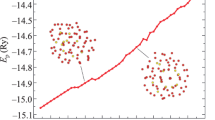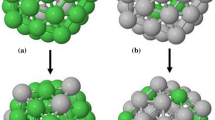Abstract
A molecular dynamics simulation was performed for silver clusters of 147, 309, and 561 atoms with the initial cuboctahedral habit in the temperature range 0–1000 K with an embedded atom potential for silver. Structural transitions of the silver clusters to complex twins (icosahedral habit) with coherent (111)/(111) boundaries over all edges of icosahedra were found, which started at temperatures of 50 K, 350 K, and 700 K, respectively. To analyze the structural transformations in nanoparticles, an algorithm is proposed based on a simplicial Delaunay decomposition (Delaunay triangulation). It was found that after the transition of silver nanoparticles to complex twins, the atomic motion becomes vibrational; the atoms vibrate around the sites that correspond to the vertices of the regular polyhedra. In the case of the 147-atom silver nanoparticle, the polyhedra are arranged in the following sequence, starting from the center of mass: icosahedron (12 atoms), icosododecahedron (30 atoms), icosahedron (12 atoms), dodecahedron (20 atoms), truncated icosahedron (60 atoms, isostructural with fullerene C60), icosahedron (12 atoms), and one atom at the center of mass.
Similar content being viewed by others
References
W. A. de Heer, Rev. Modern Physics, 65, No. 3, 611–676 (1993).
B. K. Teo and N. J. A. Sloane, Inorg. Chem., 24, 4545–4558 (1985).
T. P. Martin, Phys. Rep., 273, 199–241 (1996).
N. N. Medvedev and Yu. I. Naberukhin, J. Non-Cryst. Solids, 94, 402–406 (1987).
N. N. Medvedev, The Voronoi-Delaunay Method in the Study of the Structure of Noncrystalline Systems [in Russian], Izd-vo SO RAN, Novosibirsk (2000).
N. A. Bulienkov, Vestn. Nizhegorodsk. Un-ta im. N. P. Lobachevskogo, Ser. Fiz. Tverd. Tela, issue 1, 19–30 (1998).
N. A. Bulienkov, Quasicrystals and Discrete Geometry, The Fields Institute Monographs, 10, J. Patera (ed.), Am. Math. Soc., Providence, RI (1998), pp. 67–134.
M. Doyama and Y. Kogure, Comp. Mater. Sci., 14, 80–83 (1999).
D. K. Belashchenko, Computer Simulation of Liquid and Amorphous Substances [in Russian], MISiS, Moscow (2005).
N. A. Bulienkov and D. L. Tytik, Izv. Ross. Akad. Nauk, Ser. Khim., 50, No. 1, 1–19 (2001).
M. M. Nieto, Titius-Bode Law of Planetary Distances: Its History and Theory (Monographs in Natural Philosophy), Elsevier, Amsterdam (1972).
A. A. Vikarchuk and I. S. Yasnikov, Structure Formation in Nanoparticles and Microcrystals with Pentagonal Symmetry Formed in Electrocrystallization of Metals [in Russian], TGU, Tolyatti (2006).
Author information
Authors and Affiliations
Corresponding author
Additional information
Original Russian Text Copyright © 2008 by D. L. Tytik, D. K. Belashchenko, and A. N. Sirenko
__________
Translated from Zhurnal Strukturnoi Khimii, Vol. 49, No. 1, pp. 115–122, January–February, 2008.
Rights and permissions
About this article
Cite this article
Tytik, D.L., Belashchenko, D.K. & Sirenko, A.N. Structural transformations in silver nanoparticles. J Struct Chem 49, 109–116 (2008). https://doi.org/10.1007/s10947-008-0016-5
Received:
Issue Date:
DOI: https://doi.org/10.1007/s10947-008-0016-5




